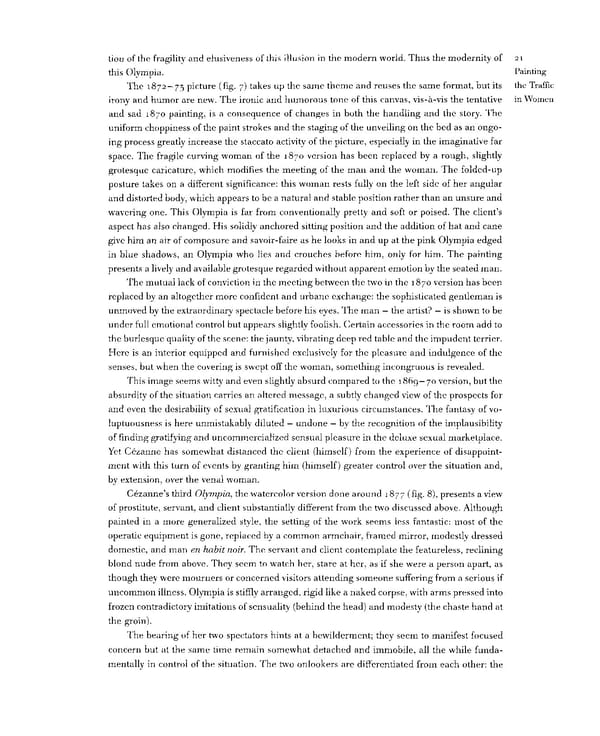tion of the fragility and elusiveness of this illusion in the modern world. Thus the modernity of 21 this Olympia. Painting The 1872-73 picture (fig. 7) takes up the same theme and reuses the same format, but its the Traffic irony and humor are new. The ironic and humorous tone of this canvas, vis-a-vis the tentative in Women and sad 1870 painting, is a consequence of changes in both the handling and the story. The uniform choppiness of the paint strokes and the staging of the unveiling on the bed as an ongo- ing process greatly increase the staccato activity of the picture, especially in the imaginative far space. The fragile curving woman of the 1870 version has been replaced by a rough, slightly grotesque caricature, which modifies the meeting of the man and the woman. The folded-up posture takes on a different significance: this woman rests fully on the left side of her angular and distorted body, which appears to be a natural and stable position rather than an unsure and wavering one. This Olympia is far from conventionally pretty and soft or poised. The client's aspect has also changed. His solidly anchored sitting position and the addition of hat and cane give him an air of composure and savoir-faire as he looks in and up at the pink Olympia edged in blue shadows, an Olympia who lies and crouches before him, only for him. The painting presents a lively and available grotesque regarded without apparent emotion by the seated man. The mutual lack of conviction in the meeting between the two in the 1870 version has been replaced by an altogether more confident and urbane exchange: the sophisticated gentleman is unmoved by the extraordinary spectacle before his eyes. The man — the artist? — is shown to be under full emotional control but appears slightly foolish. Certain accessories in the room add to the burlesque quality of the scene: the jaunty, vibrating deep red table and the impudent terrier. Here is an interior equipped and furnished exclusively for the pleasure and indulgence of the senses, but when the covering is swept off the woman, something incongruous is revealed. This image seems witty and even slightly absurd compared to the 1869 — 70 version, but the absurdity of the situation carries an altered message, a subtly changed view of the prospects for and even the desirability of sexual gratification in luxurious circumstances. The fantasy of vo- luptuousness is here unmistakably diluted — undone — by the recognition of the implausibility of finding gratifying and uncommercialized sensual pleasure in the deluxe sexual marketplace. Yet Cezanne has somewhat distanced the client (himself) from the experience of disappoint- ment with this turn of events by granting him (himself) greater control over the situation and, by extension, over the venal woman. Cezanne's third Olympia, the watercolor version done around 1877 (fig. 8), presents a view of prostitute, servant, and client substantially different from the two discussed above. Although painted in a more generalized style, the setting of the work seems less fantastic: most of the operatic equipment is gone, replaced by a common armchair, framed mirror, modestly dressed domestic, and man en habit noir. The servant and client contemplate the featureless, reclining blond nude from above. They seem to watch her, stare at her, as if she were a person apart, as though they were mourners or concerned visitors attending someone suffering from a serious if uncommon illness. Olympia is stiffly arranged, rigid like a naked corpse, with arms pressed into frozen contradictory imitations of sensuality (behind the head) and modesty (the chaste hand at the groin). The bearing of her two spectators hints at a bewilderment; they seem to manifest focused concern but at the same time remain somewhat detached and immobile, all the while funda- mentally in control of the situation. The two onlookers are differentiated from each other: the
 Prostitution & Impressionists Page 41 Page 43
Prostitution & Impressionists Page 41 Page 43